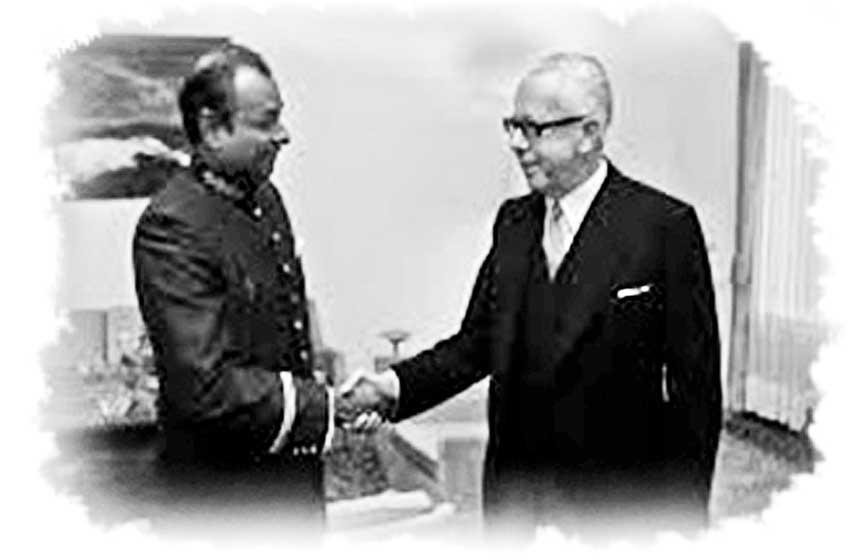14 Nov 2020 - {{hitsCtrl.values.hits}}

Arthur Ratnavale with former German President Heinemann
The unexpected passing away of Arthur Ratnavale, a former
Sri Lankam Ambassador to what was then West Germany, in 1974 cut short an illustrious life. He died of a heart attack at the age of 54. Those close to him remember his thoughtful, somewhat philosophical yet precise, confident and commanding personality.
Similar contrasts surface in his old Ceylon Civil Service administrative exactness entwining with an artistic passion influenced by the likes of his famous Trinity College art teacher David Paynter, and inspired by his admiration for the French impressionists. On his hundredth birth anniversary, which falls on November 3, 2020, this article is penned to serve both as an appreciation about him and to highlight his life’s journey.
As the sixth in a family of eight children Arthur’s career took a different route. This is compared to his other siblings who distinguish themselves in the medical field.
Educated at Trinity College Kandy, in the era of Headmaster’s such as Rev John Cambell and the Rev John Stopford, the school’s strong Christian influences manifested in many of his paintings. His links with Trinity were strong and after graduating with History Honours he came back to teach briefly. His former pupils include former Ministers Lakshman Kadiragammar who he taught English and History, and Prof Tissa Vitharana to whom he was a House Master at Napier House. Indeed, sometimes reflecting on his life, including many of the senior positions held, he would often say that he enjoyed his job as a teacher at Trinity. Fittingly, decades later he also served as a Governor of this school.
Teaching was still a brief interlude. After little over a year he sat for and passed the highly competitive Ceylon Civil Service exam. The diverse exposure the Civil Service provided would naturally have been a source of strength to the very senior positions held later in his career. This diversity included exposure in different parts of the country in the roles of: Assistant Government Agent (AGA)Matale, AGA Kurunegala and later Government Agent Ratnapura. There was exposure in different departments and Ministries such as: Customs, Trade and Commerce, Information and Broadcasting, Tourism and Census and Statistics. There was also exposure overseas including a three month training programme in Australia, visits to Peeking in the capacity of Rubber Commissioner for rubber rice talks and visits to Prague, Geneva and Rome on Government business.
Entwining with all this was his love of painting and art and before referring to the more high profile appointments he later held, the article seeks to do justice to this pastime. Contextually the observation at the outset that artistic passion represented a contrast to his administrative exactness requires qualification as even here he took meticulous care over his work. The contrast with exactness was in his unfettered and adventurous use of colour; possibly the influence of his Trinity links with David Paynter, but even more likely his favourite artist Paul Gauguin.
Two strands were evident in his art. One consists of Sri Lankan rural and jungle scenes. The other connects with his strong Christian beliefs and upbringing. I am reminded of his painting of the Cologne Cathedral interior, the expulsion of Adam and Eve from the Garden of Eden and of course the crucifixion. A painting where the two strands coincidentally combine is a view of the Hanthana hills seen through the pillars of the Trinity College Chapel.
With the advent of Sirimavo Banadaranaike’s Government in 1970 Arthur Ratnavale was appointed Permanent Secretary Defence and External Affairs.
Arthur’s last appointment as Sri Lanka’s Ambassador was to the Federal Republic of Germany. However it was not without its challenges. Relations between the countries were a little strained on account of Sri Lanka’s early recognition of East Germany when put in the context of the wider goal of German unification. He was therefore happy to see an improvement in relations after the state visit of Mrs. Bandaranaike to Germany in 1974.
Despite an involved career Arthur was a committed family man and his devoted wife Poowathie was a boundless reservoir of support both with his career and with the family. His death left a huge void in his immediate family. Being a young family member who sometimes found his passion for art galleries and museums a little bit of an ordeal, I thought differently of his love of the great outdoors and have fond memories of river baths in the Deduru Oya, boating on Germany’s Maria Lake and a family winter holiday in the Bavarian Alps. He sought to inculcate a strong educational outlook and wide interests in his children. While promoting achievement he also encouraged us to be thoughtful and to be discerningly receptive to ideas. As such in remembering him on this anniversary, it is apt in conclusion to recall a small verse that struck a chord with him to the extent that he made me memorize it:
“Men should be judged not by their tint of skin
The Gods they serve, the vintage that they drink
Nor by the way they fight or love or sin
But by the quality of thoughts they think”
(W.S.R)
27 Nov 2024 8 minute ago
27 Nov 2024 38 minute ago
27 Nov 2024 54 minute ago
27 Nov 2024 2 hours ago
27 Nov 2024 3 hours ago